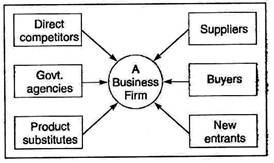There are at least top six competitors (shown below) against which a business requires advantage. The competitors are:- 1. Direct Competitors 2. Suppliers 3. Buyers 4. New Entrants 5. Product Substitutes 6. Government Agencies.
Each of them attempts to exert downward pressure on a business’s return on investment (ROI).
Competitor # 1. Direct Competitors:
These refer to firms that make products similar to a particular business firm and attempt to sell them to the same customers. To induce customers to buy their products rather than a particular firms, they engage in such practices as price reduction, promotional activity, and product development.
ADVERTISEMENTS:
If a particular business firm fails to follow suit, its customers will switch to competitors’ products, and in the process, its revenue will decline. On the other hand, to the extent that a particular firm engages in these activities, its costs will increase. Consequently, whatever response that firm makes to efforts by direct competitors to increase their sales, the particular business firm’s ROI is likely to decline, at least temporarily.
Competitor # 2. Suppliers:
They are the firms from which a particular business firm purchase their raw materials, supplies, and so on. To enhance their ROI, suppliers try to increase the price for their raw materials or induce the particular firm to accept different products, less advantageous delivery terms, and so on. To that extent, the particular firm’s ROI suffers.
Competitor # 3. Buyers:
They represent customers or consumers. Their motivation is just opposite that of suppliers. They seek lower prices, improved quality, and better delivery terms and services. The most direct way buyers can encourage a particular firm to meet their needs and preferences is to purchase a competitor’s products. Buyers’ efforts, if successful, tend to reduce the ROI of the particular firm.
Competitor # 4. New Entrants:
They represent the firms that are outside the particular firm’s industry and contemplate entry into the industry. Should one of these firms enter, the particular business entity faces yet another direct competitor vying for the same customers. By increasing the intensity of rivalry among direct competitors, actual or threatened entry tends to depress the ROI of all direct competitors including the particular firm.
Competitor # 5. Product Substitutes:
ADVERTISEMENTS:
These are products that complete in an indirect way with a particular firm’s products.
For example, coal, oil, gas, wood, solar energy, nuclear fuel, electricity, though different products often produced by different competitors, nevertheless are substitutes for each other in the sense that a given customer might substitute one product for another as relative prices change. Substitutes, thus, exert downward pressure on a particular firm’s ROI by limiting the price that can be charged on the firm’s products.
Competitor # 6. Government Agencies:
They are the regulating bodies that monitor business activities. By collecting taxes and requiring compliance to government regulations, they lower revenues and raise costs, both of which depress a particular firm’s ROI. Although the Govt. subsidies and quotas may improve a firm’s ROI, such offers are outweighed by taxes and compliance.
